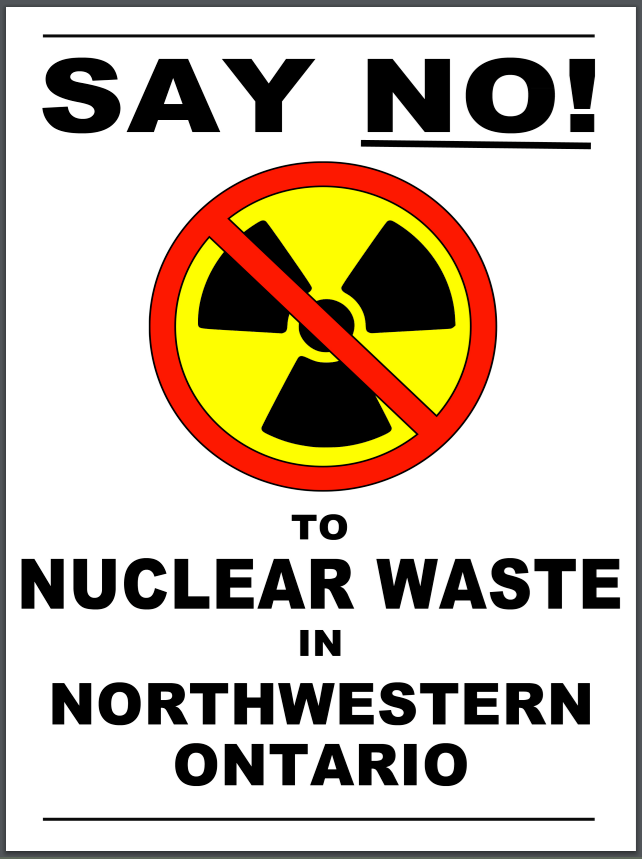Previously published in the Winnipeg Free Press August 2, 2024

By Anne Lindsey
Anyone driving Highway 17 from Winnipeg to Thunder Bay will pass through Ignace a couple of hours east of Dryden. A modest Canadian Shield town with about 1300 inhabitants, Ignace was built on the forest industry, but like so many northern Ontario towns, today actively seeks other economic opportunities.
The alert traveller will also notice many roadside signs between Kenora and Thunder Bay, proclaiming “No Nuclear Waste in Northwest Ontario”. The issue has reached a critical juncture recently in this area.
Hosting Canada’s high-level nuclear waste repository is one of the economic development opportunities being explored by Ignace. On July 10, 2024, Ignace Town Council voted in favour of being a “willing host” for this massive storage hole in the ground and the accompanying transfer facility for the highly radioactive and toxic “spent” fuel from existing and future reactors.
The taxpayer funded Nuclear Waste Management Organization or NWMO (consisting of the owners of Canada’s nuclear waste and charged by the federal government to find a repository site) provided Ignace a half million dollar signing bonus, in addition to NWMO’s many donations and monetary contributions to local initiatives leading up to the vote.
Problems abound with this “willingness” declaration, not the least of which is that the site in question is not even in Ignace or in the same watershed. The Revell batholith site, 45 kilometres west of Ignace, lies on the watersheds of both the Rainy River which flows into Lake of the Woods, and thence to the Winnipeg River and Lake Winnipeg, and the English River which flows north through Lac Seul and into Lake Winnipeg.
The waste will remain dangerous for literally millennia. Burying unretrievable nuclear waste in an excavated rock cavern that is deep underground where groundwater flows through the rock and eventually links to surface bodies has never been tested in real life. The industry relies on computer models to persuade us that future generations will not be at risk.
The waste will have to be transported to Revell, mostly from Southern Ontario and New Brunswick – several massive shipments daily for 40 years for the existing waste – along the often-treacherous route skirting Lake Superior. It must then be “repackaged” in a surface facility into burial canisters. Little is publicly known about what this entails, but any accidents and even routine cleaning will result in radioactive pollution to the surrounding waters posing a more immediate risk.
First Nations along the downstream routes have expressed their opposition to this project. Chief Rudy Turtle of Asubpeeschoseewagong (Grassy Narrows) was clear in his letter to the CEO of NWMO: “The water from that site flows past our reserve and into the waters where we fish, drink, and swim. The material that you want to store there will be dangerous for longer than Canada has existed, longer than Europeans have been on Turtle Island, and longer than anything that human beings have ever built has lasted. How can you reliably claim that this extremely dangerous waste will safely be contained for hundreds of thousands of years?”
His views are echoed by neighbouring chiefs, and other Treaty 3 First Nations have rejected nuclear waste transportation and abandonment through and in their territories. Wabigoon First Nation, the closest to the Revell site, will hold its own community referendum on willingness to host the site this fall. It’s not known how much money or other inducements NWMO has offered for a signing bonus.
In 1986, a citizens group in the Eastern Townships of Quebec successfully lobbied politicians on both sides of the border to reject a US proposal for a massive nuclear waste repository in Vermont, on a watershed flowing into Canada.
Around the same time, Manitoba citizens convinced our government to oppose another proposed US nuclear waste site – with potential for drainage to the Red River. And eventually, the NDP government of Howard Pawley passed Manitoba’s High-Level Radioactive Waste Act, banning nuclear waste disposal in this province.
Where does Manitoba stand today? We don’t know, even though the Revell site is not far from Manitoba and the water is flowing this way. No single town should be making decisions with such profound risks to all of our health and futures. People who depend on Manitoba rivers and lakes (including Winnipeggers, via our water supply from Shoal Lake) should be part of this decision. Now is the time for our elected officials on Broadway and Main Street to become active stakeholders and demand a voice in the nuclear waste “willingness” question.
Anne Lindsey is a long time observer of the nuclear industry and a Canadian Centre for Policy Alternatives Manitoba Research Associate


